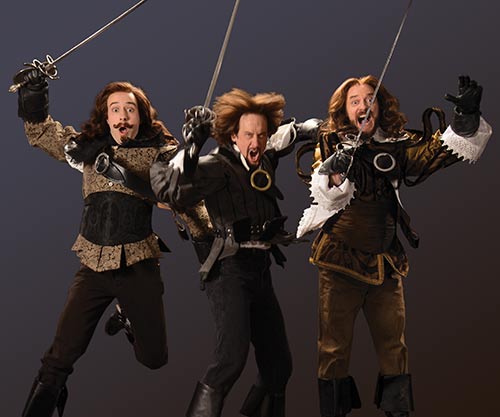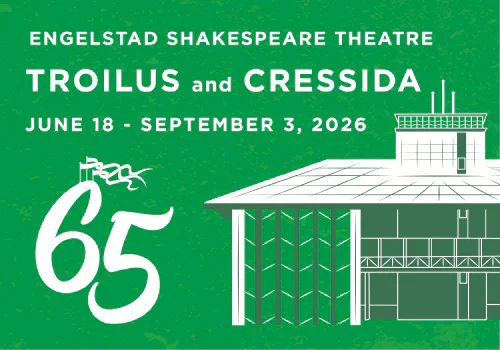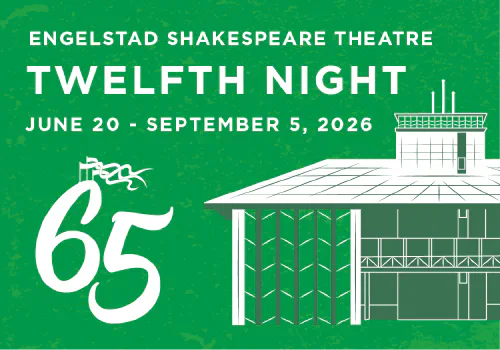The Three Musketeers: Superheroes on Stage

Tasso Feldman (left) as Aramis, J. Todd Adams as Athos, and Todd Denning as Porthos.
By Ryan D. Paul
I remember my first literary encounter with The Three Musketeers. I was sitting in the waiting room of a Midas Muffler in Layton, Utah, while my 1969 Pontiac Tempest was undergoing repairs. As I settled in for the long wait and cracked the cover of my Bantam paperback, I was swept away into the world of the Musketeers. Since that time, Athos, Porthos, Aramis, and the young d’Artagnan have become my good friends and accompanied me on many adventures. Now, once again, I get to travel with them through the Utah Shakespeare Festival’s 2016 production.
Ken Ludwig, who wrote the adaptation of The Three Musketeers, says in the Introduction to his play, “Reading The Three Musketeers . . . is like reading the best and longest comic book in the world.” The comic book essence of the story, the visual imagery combined with the snappy, driving dialogue helps propel the narrative forward. The best comics, graphic novels, books, plays, and movies are the ones that not only tell good stories, but those that also create a sense of relevancy in our lives.
Alexandre Dumas joins other notable authors such as Charles Dickens, Arthur Conan Doyle, Mark Twain, and Stephen King in that his story of the musketeers and their adventures began in serial form, printed in a French newspaper between March and July 1844. The serial format, akin to the radio dramas of the mid-twentieth century, brought readers to the precipice with each installment as action was left unresolved until the next issue. Dumas was very familiar with this method of writing and publication as it began in his homeland. “In 1836 a Parisian businessman was trying to figure out how to get subscribers in the habit of buying a daily newspaper instead of the typical weekly. He decided that the best way to hook readers was to include pieces of an original novel in his publication. He approached the most popular novelist of his day, Honorè de Balzac, and the serial novel was born.”
Noted comic book author and serial writing professional, Grant Morrison, who has penned tales of some of the most well-known superheroes such as Superman, Batman, Flash, the Justice League, and the X-men noted: “If we spin a tale of guilt and failure with an unhappy ending we will live that story to its conclusion. If on the other hand we emphasize our glory, intelligence, grace, generosity, honesty, creativity, and native genius those qualities will be made manifest in our behavior and in our works. It should give us hope that superhero stories are flourishing everywhere because they are a bright flickering sign of our need to move on, to imagine the better, more just, and more proactive people we can be.” It is no wonder that this thrilling tale has been adapted for stage and screen and in 1941 became the first issue of Russian born publisher Albert Lewis Kantner’s Classic Comics. Kanter, seeing the appeal of comic books thought that he could use this format to introduce young readers to great literature and he saw in The Three Musketeers all the elements that comics were known for.
At its core, The Three Musketeers is essentially, a superhero story. It is a tale of individuals who band together to fight against evil, tyranny, and corruption. The musketeers live by a code: “One for all and all for one.” The friends remain loyal to each other despite the machinations of Cardinal Richelieu and Lady de Winter, the troubled villains of the piece.
Dumas, with great imagination and literary flair brings France alive and invites us to share in the adventure. This summer, director B. J. Jones and the Utah Shakespeare Festival will do the same. Ken Ludwig’s adaptation captures the spirit and essence of this classic story, and, while there will be no super heroic flying, I am sure capes will be involved.









